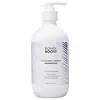What's inside
What's inside
 Key Ingredients
Key Ingredients

No key ingredients
 Benefits
Benefits

 Concerns
Concerns

 Ingredients Side-by-side
Ingredients Side-by-side

Aloe Barbadensis Leaf Juice
Skin ConditioningSodium Methyl Cocoyl Taurate
CleansingCocamidopropyl Betaine
CleansingDecyl Glucoside
CleansingCoco-Glucoside
CleansingGlyceryl Oleate
EmollientPropanediol
SolventHydrolyzed Quinoa
Skin ConditioningHydrolyzed Jojoba Esters
Skin ConditioningHydrolyzed Adansonia Digitata Seed Extract
Ceramide Ng
Skin ConditioningRicinus Communis Seed Oil
MaskingCaprylic/Capric Triglyceride
MaskingArgania Spinosa Kernel Oil
EmollientOlea Europaea Fruit Oil
MaskingArginine
MaskingHydrolyzed Collagen
EmollientRosmarinus Officinalis Leaf Extract
AntimicrobialAscophyllum Nodosum Extract
Skin ConditioningAmaranthus Caudatus Seed Extract
Skin ConditioningEquisetum Arvense Leaf Extract
AstringentAcanthopanax Senticosus Root Extract
Skin ConditioningSodium Hyaluronate
HumectantNiacinamide
SmoothingBiotin
AntiseborrhoeicPolyquaternium-7
Polyquaternium-10
Potassium Sorbate
PreservativePentylene Glycol
Skin ConditioningCaprylyl Glycol
EmollientEthylhexylglycerin
Skin ConditioningParfum
MaskingCitric Acid
BufferingAloe Barbadensis Leaf Juice, Sodium Methyl Cocoyl Taurate, Cocamidopropyl Betaine, Decyl Glucoside, Coco-Glucoside, Glyceryl Oleate, Propanediol, Hydrolyzed Quinoa, Hydrolyzed Jojoba Esters, Hydrolyzed Adansonia Digitata Seed Extract, Ceramide Ng, Ricinus Communis Seed Oil, Caprylic/Capric Triglyceride, Argania Spinosa Kernel Oil, Olea Europaea Fruit Oil, Arginine, Hydrolyzed Collagen, Rosmarinus Officinalis Leaf Extract, Ascophyllum Nodosum Extract, Amaranthus Caudatus Seed Extract, Equisetum Arvense Leaf Extract, Acanthopanax Senticosus Root Extract, Sodium Hyaluronate, Niacinamide, Biotin, Polyquaternium-7, Polyquaternium-10, Potassium Sorbate, Pentylene Glycol, Caprylyl Glycol, Ethylhexylglycerin, Parfum, Citric Acid
Colloidal Oatmeal Extract
HumectantWater
Skin ConditioningSodium C14-16 Olefin Sulfonate
CleansingCocamidopropyl Betaine
CleansingGlycol Distearate
EmollientRubus Villosus Fruit Extract
AstringentHydrolyzed Quinoa
Skin ConditioningPEG-7 Amodimethicone
HumectantPolyquaternium-22
Polyquaternium-39
PEG-150 Pentaerythrityl Tetrastearate
EmulsifyingPPG-2 Hydroxyethyl Cocamide
EmulsifyingAcrylates/C10-30 Alkyl Acrylate Crosspolymer
Emulsion StabilisingLaureth-4
EmulsifyingSodium Hydrolyzed Potato Starch Dodecenylsuccinate
Linoleamidopropyl Pg-Dimonium Chloride Phosphate
Propylene Glycol
HumectantGlycerin
HumectantCitric Acid
BufferingSodium Citrate
BufferingHexylene Glycol
EmulsifyingSodium Hydroxide
BufferingSodium Benzoate
MaskingParfum
MaskingColloidal Oatmeal Extract, Water, Sodium C14-16 Olefin Sulfonate, Cocamidopropyl Betaine, Glycol Distearate, Rubus Villosus Fruit Extract, Hydrolyzed Quinoa, PEG-7 Amodimethicone, Polyquaternium-22, Polyquaternium-39, PEG-150 Pentaerythrityl Tetrastearate, PPG-2 Hydroxyethyl Cocamide, Acrylates/C10-30 Alkyl Acrylate Crosspolymer, Laureth-4, Sodium Hydrolyzed Potato Starch Dodecenylsuccinate, Linoleamidopropyl Pg-Dimonium Chloride Phosphate, Propylene Glycol, Glycerin, Citric Acid, Sodium Citrate, Hexylene Glycol, Sodium Hydroxide, Sodium Benzoate, Parfum
Alternatives
Ingredients Explained
These ingredients are found in both products.
Ingredients higher up in an ingredient list are typically present in a larger amount.
Citric Acid is an alpha hydroxy acid (AHA) naturally found in citrus fruits like oranges, lemons, and limes.
Like other AHAs, citric acid can exfoliate skin by breaking down the bonds that hold dead skin cells together. This helps reveal smoother and brighter skin underneath.
However, this exfoliating effect only happens at high concentrations (20%) which can be hard to find in cosmetic products.
Due to this, citric acid is usually included in small amounts as a pH adjuster. This helps keep products slightly more acidic and compatible with skin's natural pH.
In skincare formulas, citric acid can:
While it can provide some skin benefits, research shows lactic acid and glycolic acid are generally more effective and less irritating exfoliants.
Most citric acid used in skincare today is made by fermenting sugars (usually from molasses). This synthetic version is identical to the natural citrus form but easier to stabilize and use in formulations.
Read more about some other popular AHA's here:
Learn more about Citric AcidCocamidopropyl Betaine is a fatty acid created by mixing similar compounds in coconut oil and dimethylaminopropylamine, a compound with two amino groups.
This ingredient is a surfactant and cleanser. It helps gather the dirt, pollutants, and other impurities in your skin to be washed away. It also helps thicken a product and make the texture more creamy.
Being created from coconut oil means Cocamidopropyl Betaine is hydrating for the skin.
While Cocamidopropyl Betaine was believed to be an allergen, a study from 2012 disproved this. It found two compounds in unpure Cocamidopropyl Betaine to be the irritants: aminoamide and 3-dimethylaminopropylamine. High-grade and pure Cocamidopropyl Betaine did not induce allergic reactions during this study.
Learn more about Cocamidopropyl BetaineWe don't have a description for Hydrolyzed Quinoa yet.
Parfum is a catch-all term for an ingredient or more that is used to give a scent to products.
Also called "fragrance", this ingredient can be a blend of hundreds of chemicals or plant oils. This means every product with "fragrance" or "parfum" in the ingredients list is a different mixture.
For instance, Habanolide is a proprietary trade name for a specific aroma chemical. When used as a fragrance ingredient in cosmetics, most aroma chemicals fall under the broad labeling category of “FRAGRANCE” or “PARFUM” according to EU and US regulations.
The term 'parfum' or 'fragrance' is not regulated in many countries. In many cases, it is up to the brand to define this term.
For instance, many brands choose to label themselves as "fragrance-free" because they are not using synthetic fragrances. However, their products may still contain ingredients such as essential oils that are considered a fragrance by INCI standards.
One example is Calendula flower extract. Calendula is an essential oil that still imparts a scent or 'fragrance'.
Depending on the blend, the ingredients in the mixture can cause allergies and sensitivities on the skin. Some ingredients that are known EU allergens include linalool and citronellol.
Parfum can also be used to mask or cover an unpleasant scent.
The bottom line is: not all fragrances/parfum/ingredients are created equally. If you are worried about fragrances, we recommend taking a closer look at an ingredient. And of course, we always recommend speaking with a professional.
Learn more about Parfum